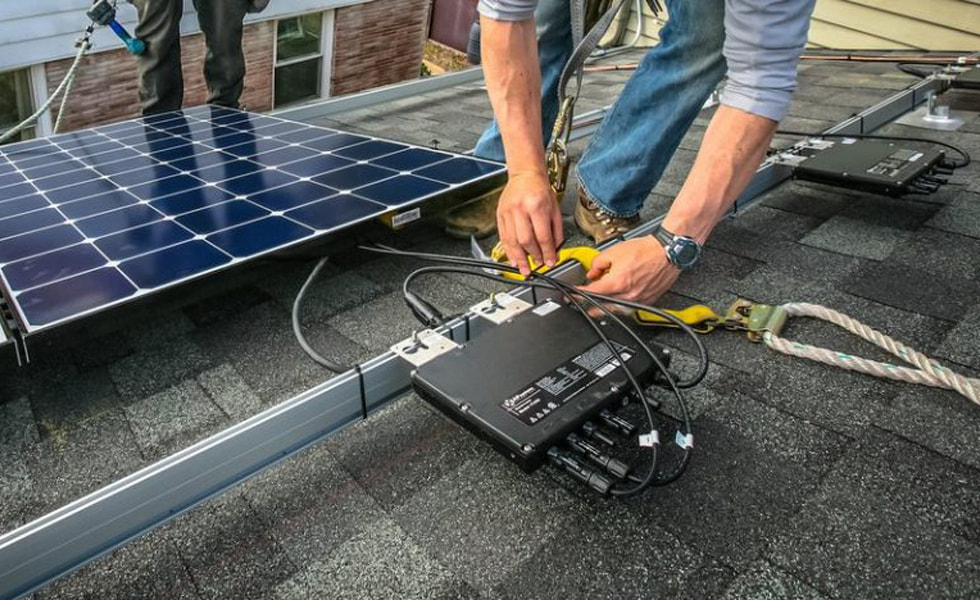
Virtually no solar power system is complete without an inverter. People even compare the importance and functionality of a solar inverter with that of a heart. It, therefore, becomes mandatory to take a look at the evolution of such a crucial component - which brings us to the comparison of traditional, string inverters with the more advanced Micro Inverter!
What Are Microinverters?
“Micro” is used to signify something that is very small. Microinverters, therefore, are tiny inverter units that can even fit in your palm, weighing around a kilogram per unit. When everything from TVs to computers is becoming slimmer and more compact, why should inverters stay behind?
Each microinverter is connected to an individual panel and converts the direct current (DC) generated by the solar panel into usable, alternating current (AC).
An increasing number of brands are also offering what they call “AC solar panels”, which are basically solar panels with integrated microinverters, so that the power flowing out of the panel is AC power, eliminating the need for a string inverter.
Since they are installed near or directly on the solar panel, microinverters are categorized as module-level power electronics (MLPE). The power rating of a microinverter is comparable not to the string or the system itself, but to the power rating of individual solar modules.
String Inverters Vs. Microinverters
The increasing popularity of microinverters is proof that they offer a number of advantages over string inverters. And yet, millions of string inverters are still purchased and installed worldwide. So which one is better for you, and how? Let's find out.
1. System Downtimes
When a string inverter fails, there is zero watts of power received from the entire string. This means until a technician arrives and fixes the inverter, your system is of no use.
Microinverters, on the other hand, work at the panel level. So, if a single microinverter fails, just one solar panel stops generating power. Additionally, a microinverter can easily be swapped for a new one, reducing the panel downtime even further.
2. Panel-Level Monitoring
Most modern string inverters come with WiFi connectivity and remote monitoring features. You can view the status of your system from your living room couch, or for that matter, anywhere in the world. However, you can only monitor your power generation at the system level. If one or two panels malfunction, it is likely that you won’t notice.
Many microinverters come with remote monitoring but at the panel level. You can see how much power every single panel is generating, so if one of the panels is producing seriously low power, you will be aware of it.
3. Performance
With string inverters, the entire string acts as one large solar panel. Therefore, even if a single solar panel in the string is performing poorly, the production of the entire string falls.
With micro-inverters, all solar panels are connected and yet operate independently. This means that if one or more panels are shaded or do not receive sufficient direct sunlight, it will not affect the panels that are not shaded.
For homes that have complex roof layouts where every solar panel cannot receive sunlight at the desired angle for the entire day, microinverters are a perfect solution.
4. Simplicity And Compactness
Microinverters are a great choice from the installer’s point of view as well. It can often be difficult to carry and install a traditional, bulky string inverter.
Microinverters are light and easy to carry. Additionally, they are designed to be plug-and-play devices, meaning they can be installed within a few minutes.
5. Sizing Restrictions
Suppose you installed a solar power system with a string inverter, and in a few months or years you decide to purchase an electric car. You want to charge your EV with solar power, and hence need a larger system. If you have a string inverter, increasing the system size is going to be complicated, and you may have to spend more than the ideal amount.
With micro-inverters, you can even increase the system size easily - whether it is just a few hundred watts or a few kilowatts. Therefore, microinverters are a preferred choice if system expansion is an option in the near future.
6. Lifespan
While string inverters perform efficiently for 10 years, microinverters can boast up to 20 years of excellent performance.
Overall, microinverters are simply more reliable and more durable.
7. Cost
Here is one area where string inverters beat microinverters. Despite the lowered cost of microinverters in the past few years, they still are significantly expensive when compared with string inverters.
